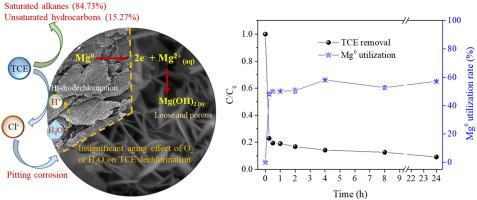Journal of Hazardous Materials ( IF 13.6 ) Pub Date : 2021-05-06 , DOI: 10.1016/j.jhazmat.2021.125993 Wenying Zhang 1 , Penggang Wei 2 , Mengfang Chen 1 , Lu Han 1 , Yingxin Zhao 2 , Jingchun Yan 1 , Linbo Qian 1 , Mingyue Gu 3 , Jing Li 1

|
The removal mechanism from the reductive dechlorination of trichloroethylene (TCE) by zero valent magnesium (ZVMg) in aqueous solution is systematically studied. Following the preparation and characterization of ball-milled micro ZVMg with graphite (ZVMg/C) particles, this paper evaluated the TCE reaction rates, pathways, utilization rates and aging effects of ZVMg/C particles in aqueous solution under uncontrolled pH conditions. Overall, 38 μM of TCE was transformed by 10 g/L of ZVMg/C to methane (62.51%) and n-hexane (11.86%) and ethane (7.40%) and other alkene and alkyne products through the catalytic hydrogenation pathway. The measured surface area normalized pseudo-first order rate constants (KSA) were up to 9.31 × 10−2 L/m2/h and the utilization rate of Mg0 accounted for around 60%. The KSA were decreased to 1.90 × 10−2 L/m2/h in case of ZVMg/C being exposed in the atmosphere for 6 days due to 7.3% reduction in the utilization rate of Mg0 from the initial 85.2%, and 5.11 × 10−2 L/m2 h in case of ZVMg/C aged in water for one day. The removal efficiencies of approximately 56%, 58% and 87% by 10 g/L of ZVMg/C were achieved in the contaminated groundwater comprising 38 μM of TCE, 43 μM of 1,2-dichlorobenzene and 8.12 μM of trichlormethane. Therefore, it is concluded that ZVMg/C is viewed as a potential and effective remediation reagent for the groundwater remediation.
中文翻译:

ZVMg / C在水溶液中的三氯乙烯脱氯速率,途径和效率
系统研究了零价镁(ZVMg)对三氯乙烯(TCE)还原脱氯的去除机理。在制备并表征了带有石墨(ZVMg / C)颗粒的球磨微型ZVMg之后,本文评估了在不受控制的pH条件下ZVMg / C颗粒在水溶液中的TCE反应速率,途径,利用率和老化效果。总体而言,通过催化加氢途径,通过10 g / L的ZVMg / C将38μM的TCE转化为甲烷(62.51%)和正己烷(11.86%)和乙烷(7.40%)以及其他烯烃和炔烃产物。测得的表面积归一化拟一阶速率常数(K SA)高达9.31×10 -2 L / m 2/ h,Mg 0的利用率约为60%。在ZVMg / C暴露于大气中6天的情况下,由于Mg 0的利用率从最初的85.2%降低7.3%,因此K SA降至1.90×10 -2 L / m 2 / h。ZVMg / C在水中老化一天的情况下为5.11×10 -2 L / m 2 h。在包含38μMTCE,43μM1,2-二氯苯和8.12μM三氯甲烷的受污染地下水中,按10 g / L ZVMg / C的去除效率约为56%,58%和87%。因此,可以得出结论,ZVMg / C被认为是用于地下水修复的潜在和有效的修复剂。



























 京公网安备 11010802027423号
京公网安备 11010802027423号